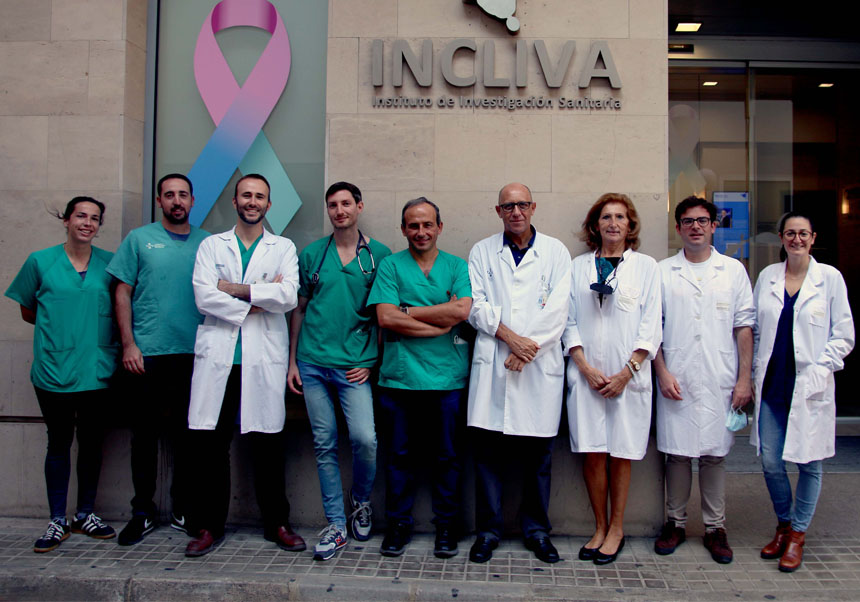5% of patients with acute myocardial infarction suffer from a lack of blood supply in affected areas
- Scientific Culture and Innovation Unit
- June 2nd, 2023

A study led by the INCLIVA Health Research Institute (of the Clinical Hospital of Valencia), and the Centre for Network Biomedical Research in Cardiovascular Diseases (CIBERCV) in collaboration with, among other centres, the University of Valencia, concludes that 5% of patients with acute myocardial infarction show regions of the heart damaged by the infarction with a poor blood supply in the months after the event. The research, published in the JACC Cardiovascular Imaging journal, highlights that these patients are more predisposed to developing changes towards a worse structure of the heart and, therefore, to a reduction in cardiac function.
Acute myocardial infarction –sudden occlusion of a coronary artery– is a pathology with a high incidence in Western countries. The results of this research, which highlights the need to continue looking for therapeutic options that help to achieve, after the infarction, a complete arrival of blood flow to the myocardium – the heart muscle, responsible for driving blood through the body through its contraction –, is reflected in a work in which the Vall d’Hebron Hospital, the Clinical Hospital of Barcelona and the Polytechnic University of Valencia have also collaborated.
The main researchers of the project have been doctors Vicente Bodí, coordinator of the INCLIVA Translational Research Group in Ischemic Cardiopathy and attached to CIBERCV, head of the Section of the Cardiology Service of the Clinical Hospital of Valencia and full professor of the Department of Medicine of the University of Valencia (UV); César Ríos, from the same INCLIVA research group; and José Gavara, from the UPV Centre for Biomaterials and Tissue Engineering.
Ischemic heart disease encompasses a group of pathologies characterised by an insufficient supply of oxygen to the heart in relation to the demand. Despite the fact that great advances have been made in recent years with the development of techniques to open the occluded vessel, around half of the patients show areas of the myocardium with reduced blood flow the days after the infarction, which persists in 5% of them later. For this reason, continuing research in the field of acute myocardial infarction and deepening the clinical understanding of this phenomenon is of great interest to advance in the management of patients in this setting.
The multicenter study included 471 patients diagnosed with acute myocardial infarction from the Clinical Hospital of Valencia, the Vall d’Hebron Hospital in Barcelona and the Clinical Hospital of Barcelona, the result of a collaborative registry between the three hospitals for more than 5 years. All participants underwent two cardiac magnetic resonance tests to assess myocardial structure and function during the weeks following the cardiovascular event.
Subsequently, in a central laboratory of the Polytechnic University of Valencia, the imaging studies were analysed to perform a homogeneous quantification of the main indices of cardiac damage. Likewise, a systematic collection of the main clinical and cardiac imaging indices of these patients was made.
This project has obtained funding from the Carlos III Health Institute, regional development funds (FEDER) and the Valencian Government within the framework of a PROMETHEUS program for research groups of excellence in the Valencian Community. Doctors José Fernando Rodríguez-Palomares, from the Cardiology Service of the Vall d’Hebron Hospital; José Tomás Ortiz, from the Cardiology Service of the Clinical Hospital of Barcelona; and David Moratal, also from the Centre for Biomaterials and Tissue Engineering at the UPV.
Article: Bodi et al. «Impact of Persistent Microvascular Obstruction Late After STEMI on Adverse LV Remodeling: A CMR Study». JACC: Cardiovascular Imaging. Available online 12 April 2023. DOI: https://doi.org/10.1016/j.jcmg.2023.01.021
















